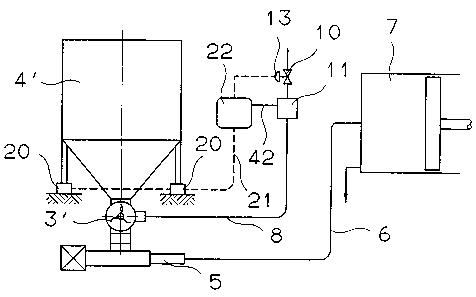Une partie des informations de ce site Web a été fournie par des sources externes. Le gouvernement du Canada n'assume aucune responsabilité concernant la précision, l'actualité ou la fiabilité des informations fournies par les sources externes. Les utilisateurs qui désirent employer cette information devraient consulter directement la source des informations. Le contenu fourni par les sources externes n'est pas assujetti aux exigences sur les langues officielles, la protection des renseignements personnels et l'accessibilité.
L'apparition de différences dans le texte et l'image des Revendications et de l'Abrégé dépend du moment auquel le document est publié. Les textes des Revendications et de l'Abrégé sont affichés :
| (12) Brevet: | (11) CA 2136333 |
|---|---|
| (54) Titre français: | PROCEDE POUR LA SEPARATION DE SOLIDES ET DE LIQUIDES, ET INSTALLATION UTILISEE A CES FINS |
| (54) Titre anglais: | PROCESS FOR SEPARATING SOLID AND LIQUID PORTIONS, AND APPARATUS FOR PERFORMING THE PROCESS |
| Statut: | Périmé et au-delà du délai pour l’annulation |
| (51) Classification internationale des brevets (CIB): |
|
|---|---|
| (72) Inventeurs : |
|
| (73) Titulaires : |
|
| (71) Demandeurs : |
|
| (74) Agent: | GOWLING WLG (CANADA) LLP |
| (74) Co-agent: | |
| (45) Délivré: | 2004-10-26 |
| (86) Date de dépôt PCT: | 1994-03-11 |
| (87) Mise à la disponibilité du public: | 1994-10-13 |
| Requête d'examen: | 2001-03-05 |
| Licence disponible: | S.O. |
| Cédé au domaine public: | S.O. |
| (25) Langue des documents déposés: | Anglais |
| Traité de coopération en matière de brevets (PCT): | Oui |
|---|---|
| (86) Numéro de la demande PCT: | PCT/CH1994/000052 |
| (87) Numéro de publication internationale PCT: | WO 1994022332 |
| (85) Entrée nationale: | 1994-11-21 |
| (30) Données de priorité de la demande: | ||||||
|---|---|---|---|---|---|---|
|
A process to separate insoluble solid portions from soluble
liquid materials of fruits with increased performance and yield
using a press (7) wherein water, is first supplied to a mill for
crushing the fruit. The soluble materials are then separated
from the solid portions as juice in the press (7). The
relationship between water feed and fruit feed can be controlled
by means of microprocessor (22). An apparatus for carrying out
this process is also disclosed.
Note : Les revendications sont présentées dans la langue officielle dans laquelle elles ont été soumises.
Note : Les descriptions sont présentées dans la langue officielle dans laquelle elles ont été soumises.

2024-08-01 : Dans le cadre de la transition vers les Brevets de nouvelle génération (BNG), la base de données sur les brevets canadiens (BDBC) contient désormais un Historique d'événement plus détaillé, qui reproduit le Journal des événements de notre nouvelle solution interne.
Veuillez noter que les événements débutant par « Inactive : » se réfèrent à des événements qui ne sont plus utilisés dans notre nouvelle solution interne.
Pour une meilleure compréhension de l'état de la demande ou brevet qui figure sur cette page, la rubrique Mise en garde , et les descriptions de Brevet , Historique d'événement , Taxes périodiques et Historique des paiements devraient être consultées.
| Description | Date |
|---|---|
| Le délai pour l'annulation est expiré | 2006-03-13 |
| Lettre envoyée | 2005-03-11 |
| Accordé par délivrance | 2004-10-26 |
| Inactive : Page couverture publiée | 2004-10-25 |
| Inactive : Taxe finale reçue | 2004-08-11 |
| Préoctroi | 2004-08-11 |
| Un avis d'acceptation est envoyé | 2004-06-25 |
| Lettre envoyée | 2004-06-25 |
| Un avis d'acceptation est envoyé | 2004-06-25 |
| Inactive : Approuvée aux fins d'acceptation (AFA) | 2004-05-26 |
| Modification reçue - modification volontaire | 2003-11-20 |
| Inactive : Dem. de l'examinateur par.30(2) Règles | 2003-05-22 |
| Modification reçue - modification volontaire | 2001-07-20 |
| Inactive : Dem. traitée sur TS dès date d'ent. journal | 2001-04-11 |
| Lettre envoyée | 2001-04-11 |
| Inactive : Renseign. sur l'état - Complets dès date d'ent. journ. | 2001-04-11 |
| Toutes les exigences pour l'examen - jugée conforme | 2001-03-05 |
| Exigences pour une requête d'examen - jugée conforme | 2001-03-05 |
| Demande publiée (accessible au public) | 1994-10-13 |
Il n'y a pas d'historique d'abandonnement
Le dernier paiement a été reçu le 2004-02-16
Avis : Si le paiement en totalité n'a pas été reçu au plus tard à la date indiquée, une taxe supplémentaire peut être imposée, soit une des taxes suivantes :
Veuillez vous référer à la page web des taxes sur les brevets de l'OPIC pour voir tous les montants actuels des taxes.
| Type de taxes | Anniversaire | Échéance | Date payée |
|---|---|---|---|
| TM (demande, 4e anniv.) - générale | 04 | 1998-03-11 | 1998-02-19 |
| TM (demande, 5e anniv.) - générale | 05 | 1999-03-11 | 1999-02-12 |
| TM (demande, 6e anniv.) - générale | 06 | 2000-03-13 | 2000-02-22 |
| TM (demande, 7e anniv.) - générale | 07 | 2001-03-12 | 2001-02-16 |
| Requête d'examen - générale | 2001-03-05 | ||
| TM (demande, 8e anniv.) - générale | 08 | 2002-03-11 | 2002-02-22 |
| TM (demande, 9e anniv.) - générale | 09 | 2003-03-11 | 2003-02-14 |
| TM (demande, 10e anniv.) - générale | 10 | 2004-03-11 | 2004-02-16 |
| Taxe finale - générale | 2004-08-11 |
Les titulaires actuels et antérieures au dossier sont affichés en ordre alphabétique.
| Titulaires actuels au dossier |
|---|
| BUCHER-GUYER AG MASCHINENFABRIK |
| Titulaires antérieures au dossier |
|---|
| EDUARD HARTMANN |